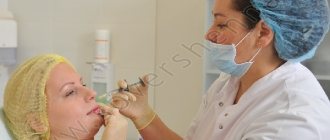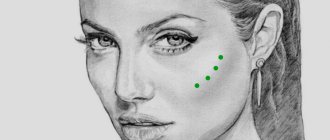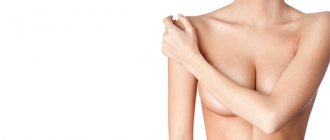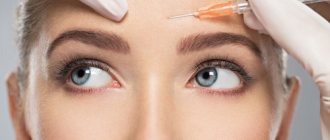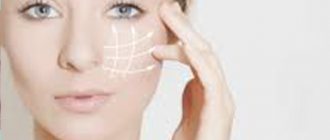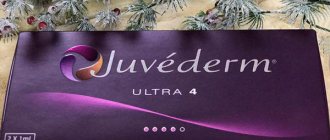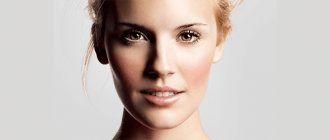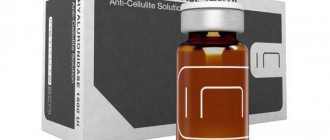After a certain amount of time, the skin of the face loses its firmness and elasticity, and the oval of the face ceases to be clear. The cheeks lose their volume. The corners of the mouth droop down. All these changes do not please us, but on the contrary upset us and give rise to complexes. Both female and male genders suffer from age-related changes. What to do, age makes itself felt.
Previously, to prolong beauty and youth, you would have to visit a plastic surgeon.
Today, new correction methods are used in the field of injection cosmetology.
Facial contouring is an effective solution for eliminating age-related changes. The method is non-surgical and gentle. Has no age restrictions.
Contour plastic surgery can not only eliminate wrinkles and restore youth to the skin, but also make lips fuller, restore volume in the cheekbone area, change the shape of the nose or chin, remove bags under the eyes, and make the look more open.
The advantages of facial contouring will be:
- minimal discomfort;
- absence of scars and cicatrices on the skin;
- execution speed;
- high result;
- fast rehabilitation period;
- natural look;
- long-term preservation of the effect;
Facial contouring is performed using products based on hyaluronic acid, collagen, poly-L-lactic acid, and calcium hydroxyapatite.
The procedure is done in a cosmetology salon after a preliminary diagnosis of the skin.
Preparations for contour plastic surgery
To correct the face, products are used based on:
- hyaluronic acid;
- collagen;
- calcium hydroxyapatite;
- polylactic acid;
Hyaluronic acid is considered the most common tool for facial plastic surgery. When it enters the body, it replenishes the missing volumes and starts the regenerative process.
Collagen fillers quickly restore volume in the desired areas, but can provoke allergic reactions.
When calcium hydroxyapatite enters the body, it begins to act instantly, and the risk of allergic reactions from it is minimal.
Fillers with polylactic acid are good because they have long-lasting results. When injected into the skin, the effects of polylactic acid can last up to 24 months.
Our clinic uses drugs from Pluryal volume and Pluryal classic.
The manufacturer of Pluryal fillers is the European company MD Skin Solutions, which uses modern methods of drug production. MD Skin Solutions has established itself as a global leader among other anti-aging product manufacturers.
Navigation:
- More details
- Injection procedures for
- How is contouring done?
Cheek contouring refers to the injection of fillers and “beauty cocktails” for the following purposes:
- smooth out wrinkles, folds, eliminate age-related ptosis;
- get rid of acne, pustular rashes;
- even out skin texture, remove acne and scars;
- remove pigmentation and rosacea (“spider veins”);
- model the oval of the face (by “adding” volume);
- correct asymmetry (cheeks of different sizes or shapes).
In a narrow sense, cheek contouring involves modeling the shape or size of the cheeks. Broadly, it also eliminates signs of aging and skin defects.
The difference between contouring and plastic surgery
Features of contour plastic surgery are the non-surgical method. No surgical intervention is used.
The drugs used to correct the zones are compatible with our body and are not perceived as “foreign”; rejection does not occur.
Contour plastic surgery has a minimal percentage of side effects in the form of allergic reactions.
After the procedure, a long recovery period is not required.
Based on the recommendations of the cosmetologist, the patient must follow the following rules: refrain from visiting the bathhouse and sauna for one week and do not sunbathe for 10 days, do not perform facial massage for 2 weeks.
How is cheekbone contouring done?
Before the procedure, the patient is prohibited from drinking alcohol, playing sports, or performing any serious cosmetic procedures. There is no need for special tests, and after a day they begin cheekbone contouring.
First, a consultation is held, during which a filler is selected and the intricacies of the work are discussed. The algorithm of actions of a cosmetologist when performing the procedure is as follows:
- facial skin is cleansed;
- the boundaries of the treated area are determined;
- the skin is disinfected with an antiseptic;
- filler is injected;
- repeated disinfection is carried out.
The procedure may be accompanied by slight pain, but an anesthetic cream is applied at the patient's request. The session lasts from 30 minutes. The cost depends on the drug chosen and its quantity.
Read more
Malarplasty: cheekbone augmentation with implants
Lipofilling has an objective limitation to its use: in a patient with a low percentage of body fat, it is difficult to obtain the required number of fat cells due to the poor development of subcutaneous tissue. In such a situation, a full-fledged plastic surgery may be recommended - cheekbone augmentation with implants.
The implant can be a silicone prosthesis or the patient's own cartilage tissue. Each option has its own advantages and disadvantages. If a silicone implant is used during cheek surgery, a protective shell of fibrous tissue may subsequently form around it. However, it does not affect the aesthetics of the cheekbones and face as a whole.
A cartilage implant (a fragment of the patient’s own cartilage tissue) is completely immunologically compatible with tissues, but cartilage is susceptible to the action of enzyme systems. In rare cases, partial resorption (destruction by enzymes) of the implant occurs, which can have a negative impact on the aesthetic result of plastic surgery. Due to the high percentage of resorption, surgeons abandoned the use of autologous bone grafts.
What there can be no doubt about is that after the operation there will be no visible marks left on the face. There will be no scars on the skin, since the plastic surgeon places the implants through incisions in the oral mucosa. The mucous membrane has the highest regenerative potential, recovery is fast. The wound heals in a few days. In the early rehabilitation period, it is enough to strengthen oral hygiene measures, avoid solid foods, hot or cold dishes and drinks.
Lipofilling: cheekbone augmentation with your own fat
If contouring is a cosmetic procedure, then lipofilling is a plastic surgery, albeit a gentle one that does not leave visible marks. A plastic surgeon performs lipofilling of the cheekbones. The operation takes place in three stages. All manipulations are carried out under local anesthesia; as a rule, there is no need for anesthesia.
At the first stage, the plastic surgeon takes adipose tissue for subsequent transplantation. The source of fat cells is an area of the body with good development of subcutaneous tissue. As a rule, the anterior wall of the abdomen, buttocks or thighs is used as a donor. The plastic surgeon removes fat cells using gentle water-jet liposuction, which does not damage blood vessels and allows you to obtain intact, viable cells.
At the second stage of the operation, the material is sent to the laboratory. In the laboratory, fat cells are cleaned of impurities (liposuction solution, blood, dead cells) and saturated with growth factors, which improve graft survival in the correction area.
The third stage of the operation is the introduction of a fraction of viable cells into the tissue of the correction zone, in this case, in the area of the zygomatic eminence. To do this, the plastic surgeon uses the injection method. Fat is injected through atraumatic cannulas with a blunt end, without incisions. Tissue trauma during surgery is minimal. Complications are excluded; minor side effects such as hematomas and swelling of the recipient area disappear within a few days.
The advantage of the operation is a lasting and most natural result. Lipofilling allows you to achieve a uniform increase in cheekbones. The face after surgery looks harmonious and proportional. Fat cells integrate into the tissue architecture, do not cause inflammatory reactions, and do not provoke an immune response. The result lasts for many years, which distinguishes this technique favorably from contour correction.
Another advantage of lipofilling is its anti-aging effect. The cheekbone correction procedure triggers the processes of self-healing and renewal of the tissues of the middle third of the face. A rejuvenating effect is achieved due to the fact that the fat graft contains many stem cells; in addition, before transplantation, it is enriched with growth factors that stimulate the regeneration process at the cellular and tissue level.
Wide, low cheekbones don't suit you? This will be corrected by surgery to reduce the cheek bones (reduction malarplasty). 1 day in hospital, 2 months until complete rehabilitation. The result will last a lifetime.
Wide, high cheekbones can be seen on many supermodels - but in real life, those with wide cheekbones are often unhappy with this feature. Why?
The European Cromanoid type with a strong bone structure is characterized by prominent cheekbones, curved at the eye sockets and tapering towards the chin. The upper part of such a zygomatic bone protrudes forward (frontally) from the plane of the face much more than the lower edge. Shaped cheekbones are in demand in the modeling business; they are considered to be a sign of a strong-willed character; in addition, they keep the soft tissues of the cheeks from sagging with age, allowing their owner to maintain the architecture of a youthful face longer.
With the Mongoloid type of face, the cheek bones are also often massive, have a wide and tall body, but lack relief. The zygomatic process of the upper jaw and the zygomatic bone form a single flattened, wide, protruding surface. Protruding wide and flat cheekbones do not create a beautiful, pronounced relief; the face looks massive.
The Renaissance period, when artists and sculptors were interested in mathematics and anatomy, gave us calculations of the ideal proportions of the human body. For the middle third of the face, the ideal width is determined by two ratios:
- the distance between the extreme points of the cheekbones is 4 times greater than the width of the bridge of the nose between the inner corners of the eyes;
- The width of the face between the temples is equal to its width in the region of the mandibular angle and is 10% less than the distance between the edges of the cheekbones.
Previously, owners of large, flat cheekbones could only contour them with a generous layer of decorative cosmetics. Today they offer reduction malarplasty - surgical correction of the width of the face in the cheekbone area. Reducing the cheekbones makes flattened faces more refined, petite and feminine, bringing them closer to classic proportions.
Surgical reduction (reduction) of the cheekbones gives an excellent aesthetic effect on relatively narrow faces, where the area of the cheekbone and zygomatic arch strongly protrudes beyond the boundaries of the ideal oval, while its relief is poorly defined. Since this problem is most typical for the Asian type, South Korea became the pioneer of cheekbone reduction surgery (malarplasty).
Reduction plastic surgery of the cheekbones (Cheek Bone Reduction/Zygoma Reduction) can be performed in three ways:
- cheek bone resurfacing
- osteotomy - excision of a section of the zygomatic bone
- surgical displacement of the zygomatic arch (lateral part of the zygomatic bone and lower part of the temporal bone) inward by dividing into three sections and repositioning
The reduction method is chosen by the surgeon and the patient based on the CT scan data, aesthetic objectives and physiological characteristics of the patient.
Endoscopic malarplasty without repositioning the zygomatic arch is performed under general anesthesia and leaves no marks on the face. It is performed through one incision (in the mouth along the alveolar arch at the level of the incisors) in the case of bone grinding, through three incisions (in the mouth and in the scalp in the area of each temple) in the case of osteosynthesis. The length of the incisions ranges from a few millimeters to 3-5 cm. The risk of damage to the facial nerves during surgery is minimal. In complex cases requiring massive intervention, a combination of malarplasty and endoscopic facelift may be recommended for patients over 30-35 years of age.
The average postoperative hospital stay is 1 day. The active rehabilitation period lasts about 14 days: due to tissue swelling, a compression face mask must be used during this period. As after other operations with intraoral access, after malarplasty there are restrictions on food for some time. Complete facial restoration takes 2-6 months.
In Moscow, malarplasty for aesthetic reasons began relatively recently: unlike South Korean, Singaporean or Chinese surgeons who use standard solutions for pronounced Asian types, Russian specialists work with patients with a mixed type - and for the aesthetic success of the operation an individual approach to each is necessary occasion.
Dr. Guryanov has his own VIP Studio virtual plastic laboratory at his disposal, which allows you to create an individual 3D model based on computed tomography data and three-dimensional light scanning of the face, head and neck. Before malarplasty, the surgeon and the patient plan with high accuracy the desired volume of intervention on a computer model, the system performs calculations, and the result of the operation based on them meets the client’s expectations.
Injection procedures for cheek correction
Our clinic performs a number of injection procedures of different types: injections with fillers (fillers), Botox and Dysport injections, biorevitalization, Plasma therapy, hyaluronic acid injections, mesotherapy and others.
The choice of a specific injection technique depends on the condition of the patient’s skin and her wishes (what problems she wants to eliminate). Our cosmetologists are very attentive to their patients and do everything possible to ensure that the result of cheek contouring exceeds all expectations.
Please note that some injection techniques require one-time visits to a cosmetologist (for example, Botox, fillers). Others require a course of several procedures at a certain interval (from 3 to 7-8 procedures). The exact amount is announced by the cosmetologist after assessing the condition of the skin.
